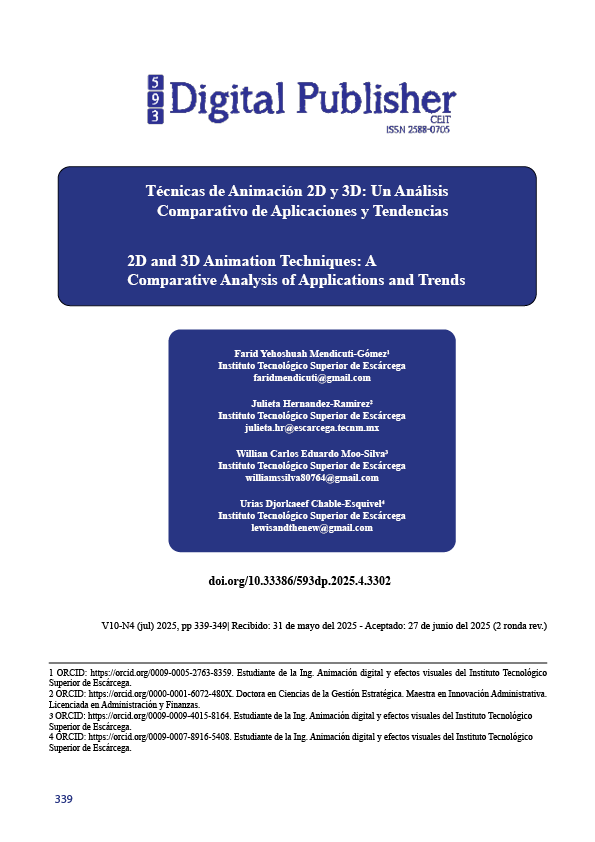2D and 3D Animation Techniques: A Comparative Analysis of Applications and Trends
Main Article Content
Abstract
This study presents a comparative analysis of 2D and 3D animation techniques through a systematic literature review based on the PRISMA protocol. A total of 30 studies published between 2020 and 2025—mostly from the Ibero-American region—were examined. These works come from diverse disciplines such as computer science, digital art, education, and visual communication. The objective is to identify technical, expressive, and contextual differences between both animation approaches, as well as to examine the rise of hybrid models enhanced by artificial intelligence. Four key application contexts were identified: professional production, educational environments, sociocultural awareness campaigns, and artistic or experimental projects. Findings reveal that 2D animation stands out for its expressiveness, accessibility, and pedagogical versatility, while 3D animation is recognized for its realism, automation, and industrial efficiency. The study proposes a functional classification of these techniques, emphasizing their narrative value, technological potential, and interdisciplinary relevance.
Downloads
Article Details

This work is licensed under a Creative Commons Attribution-NonCommercial-ShareAlike 4.0 International License.
1. Derechos de autor
Las obras que se publican en 593 Digital Publisher CEIT están sujetas a los siguientes términos:
1.1. 593 Digital Publisher CEIT, conserva los derechos patrimoniales (copyright) de las obras publicadas, favorece y permite la reutilización de las mismas bajo la licencia Licencia Creative Commons 4.0 de Reconocimiento-NoComercial-CompartirIgual 4.0, por lo cual se pueden copiar, usar, difundir, transmitir y exponer públicamente, siempre que:
1.1.a. Se cite la autoría y fuente original de su publicación (revista, editorial, URL).
1.1.b. No se usen para fines comerciales u onerosos.
1.1.c. Se mencione la existencia y especificaciones de esta licencia de uso.
References
Amador García, E. M., Díaz Alemán, M. D., & de la Torre Cantero, J. (2023). Gramática cinematográfica y animación 3D para la divulgación de la ciencia. Fotocinema. Revista Científica de Cine y Fotografía, (27), 33–56. https://doi.org/10.24310/Fotocinema.2023.vi27.16510
Amador, M. N. (2023, mayo 1). Desarrollo de animación piloto para una serie animada sobre la historia de Honduras con técnicas de animación 2D y 3D [Tesis de pregrado, UNITEC]. https://repositorio.unitec.edu/xmlui/handle/123456789/9231
Andrea, F. V. (2023, noviembre 16). Desarrollo de una producción audiovisual animada con técnicas de motion graphics 2D e ilustración [Trabajo de grado]. https://hdl.handle.net/10115/26297
Andrés, F. S. (2022, octubre 17). Aprender los procesos de animación 3D, concept art, producción y fondos mediante la experiencia adquirida en el desarrollo del cineminuto animado Yo de Piro & Nola [Trabajo de grado, Universidad de La Sabana]. http://hdl.handle.net/10818/52540
Berna-Martínez, J. V., & Universidad de Alicante, Departamento de Tecnología Informática y Computación. (2023, septiembre 18). Loop animado 3D estilo cartoon. http://hdl.handle.net/10045/137319
Cai, Z. (2024). The emotional impact of animation on its audience. Communications in Humanities Research, 52(1), 18–26. https://doi.org/10.54254/2753-7064/2024.17873
Chen, S., & Zwicker, M. (2021). Improving the perceptual quality of 2D animation interpolation. arXiv. https://doi.org/10.48550/arxiv.2111.12792
Concepción, A. V. M., & Jesús, P. L. (2020). Actualización de las técnicas 2D en la animación contemporánea [Tesis de grado, Universidad de Granada]. https://hdl.handle.net/10481/98941
David, A. G. K., & Alexander, C. O. M. (2021, enero 1). Flipbook digital como herramienta para la producción de animación 2D de bajo presupuesto [Tesis de pregrado]. http://repositorio.unibe.edu.ec/xmlui/handle/123456789/474
Díaz Manzanas, A. (2022, diciembre 1). Realización de un video de animación conceptual [Trabajo de grado]. https://hdl.handle.net/11000/29233
Elisa, M. M. (2024, junio 1). Cortometraje de animación 2D Black Sanga: The Prototype [Tesis de grado]. https://hdl.handle.net/11000/33336
Elisabet, F. G. (2024, julio 9). El arte de lo efímero: Creación de un cortometraje de animación híbrida [Trabajo final]. https://upcommons.upc.edu/handle/2117/416972
El-Mashad, S. Y., & Hamed, E. S. (2021). Automatic creation of a 3D cartoon from natural language story. Ain Shams Engineering Journal, 13(3), 101641. https://doi.org/10.1016/j.asej.2021.11.010
Elizabeth, S. C. P. (2022, mayo 20). El storyboard y la animática como herramientas en la animación 2D y 3D [Trabajo de grado]. http://dspace.ucuenca.edu.ec/handle/123456789/38981
Ernesto, W. R. J. (2020). El sonido del Sol: Cortometraje animado 2D tradigital en solitario sobre la autoaceptación a través de la conexión con otras personas en una sociedad homofóbica [Trabajo de grado]. https://hdl.handle.net/20.500.12724/17460
Even, M., Bénard, P., & Barla, P. (2025). Inbetweening with occlusions for non-linear rough 2D animation. Computers & Graphics, 104223.
https://doi.org/10.1016/j.cag.2025.104223
Garcia-Rodriguez, J., David, M. P., & Universidad de Alicante, Departamento de Tecnología Informática y Computación. (2025, enero 16). Generación de animaciones en Unreal Engine usando sistemas de captura de movimiento. http://hdl.handle.net/10045/150908
Gong, Y. (2023). The blend of reality and illusion: Analysis of the artistic characteristics of stop-motion animation. In La mezcla de la realidad y la ilusión: Análisis de las características artísticas de la animación para detener la moción (pp. 545–551). https://doi.org/10.2991/978-2-494069-97-8_69
Harvey, F. G., Yurick, M., Nowrouzezahrai, D., & Pal, C. (2020). Robust motion in- betweening. ACM Transactions on Graphics, 39(4). https://doi.org/10.1145/3386569.3392480
Hushain, J., Gupta, V., & Sharma, A. (2023). An analysis of the various kinds of animation. Zenodo (CERN European Organization for Nuclear Research). https://doi.org/10.5281/zenodo.7966112
Leonardo, T. C. B. (2022, enero 19). Animación 2D aplicada al storytelling como herramienta informativa de concientización sobre el trastorno depresivo mayor en jóvenes adultos en el Centro de Reposo y Adicciones, C.R.A. [Tesis de grado]. http://dspace.ucuenca.edu.ec/handle/123456789/37813
López, J. P., & Valdivieso, C. A. (2022). Procesos híbridos en animación experimental. Visual Review: International Visual Culture Review / Revista Internacional de Cultura Visual, 11(4), 1–9. https://doi.org/10.37467/revvisual.v9.3700
Lucas, L., & Universidad de Alicante, Departamento de Tecnología Informática y Computación. (2024, enero 24). Realización de un cortometraje de animación en 3D. http://hdl.handle.net/10045/139968
Mantilla, J., & Rolón-Rodríguez, B. M. (2023). La fluidez de la animación 2D y 3D. Convicciones. https://www.fesc.edu.co/Revistas/OJS/index.php/convicciones/article/view/1380
Manuel, N. P. J. (2020, septiembre 3). Manual de producción audiovisual de cine animado a través de la Universidad Miguel Hernández: Producción y realización de un videoclip de animación 2D para el director Carlo Avventi. http://hdl.handle.net/11000/25631
Mejía, A. R. (2022, noviembre 14). Una mirada panorámica al modelado y animación 3D con un enfoque descriptivo, desde un programa de Diseño Gráfico hasta la producción audiovisual. IGNIS. https://revistas.cun.edu.co/index.php/ignis/article/view/1018
Moreno, I. (2023). Utilización de técnicas 3D en proyectos de animación 2D. Universidad Mayor. https://repositorio.umayor.cl/xmlui/handle/sibum/8896
Oliva, V. M. (2020). La lucha cinematográfica entre Oriente y Occidente: Studio Ghibli versus Disney. Cuestiones Pedagógicas, 1(29), 112–122. https://doi.org/10.12795/cp.2020.i29.09
ORCID. (s.f.). https://orcid.org/0000-0001-6468-2299
Praveen, C. K., & Srinivasan, K. (2022). Psychological impact and influence of animation on viewer’s visual attention and cognition: A systematic literature review, open challenges, and future research directions. Computational and Mathematical Methods in Medicine, 2022, 1–29. https://doi.org/10.1155/2022/8802542
Gong, Y. (2023). The blend of reality and illusion: Analysis of the artistic characteristics of stop-motion animation. In La mezcla de la realidad y la ilusión: Análisis de las características artísticas de la animación para detener moción (pp. 545–551). https://doi.org/10.2991/978-2-494069-97-8_69
Harvey, F. G., Yurick, M., Nowrouzezahrai, D., & Pal, C. (2020). Robust motion in- betweening. ACM Transactions on Graphics, 39(4). https://doi.org/10.1145/3386569.3392480
Hushain, J., Gupta, V., & Sharma, A. (2023). An analysis of the various kinds of animation. Zenodo (CERN European Organization for Nuclear Research). https://doi.org/10.5281/zenodo.7966112
Leonardo, T. C. B. (2022, enero 19). Animación 2D aplicada al storytelling como herramienta informativa de concientización sobre el trastorno depresivo mayor en jóvenes adultos en el Centro de Reposo y Adicciones, C.R.A. [Tesis de grado]. http://dspace.ucuenca.edu.ec/handle/123456789/37813
López, J. P., & Valdivieso, C. A. (2022). Procesos híbridos en animación experimental. Visual Review: International Visual Culture Review / Revista Internacional de Cultura Visual, 11(4), 1–9. https://doi.org/10.37467/revvisual.v9.3700
Lucas, L., & Universidad de Alicante, Departamento de Tecnología Informática y Computación. (2024, enero 24). Realización de un cortometraje de animación en 3D. http://hdl.handle.net/10045/139968
Mantilla, J., & Rolón-Rodríguez, B. M. (2023). La fluidez de la animación 2D y 3D. Convicciones. https://www.fesc.edu.co/Revistas/OJS/index.php/convicciones/article/view/1380
Manuel, N. P. J. (2020, septiembre 3). Manual de producción audiovisual de cine animado a través de la Universidad Miguel Hernández: Producción y realización de un videoclip de animación 2D para el director Carlo Avventi. http://hdl.handle.net/11000/25631
Mejía, A. R. (2022, noviembre 14). Una mirada panorámica al modelado y animación 3D con un enfoque descriptivo, desde un programa de Diseño Gráfico hasta la producción audiovisual. IGNIS. https://revistas.cun.edu.co/index.php/ignis/article/view/1018
Moreno, I. (2023). Utilización de técnicas 3D en proyectos de animación 2D. Universidad Mayor. https://repositorio.umayor.cl/xmlui/handle/sibum/8896
Oliva, V. M. (2020). La lucha cinematográfica entre Oriente y Occidente: Studio Ghibli versus Disney. Cuestiones Pedagógicas, 1(29), 112–122. https://doi.org/10.12795/cp.2020.i29.09
ORCID. (s.f.). https://orcid.org/0000-0001-6468-2299
Praveen, C. K., & Srinivasan, K. (2022). Psychological impact and influence of animation on viewer’s visual attention and cognition: A systematic literature review, open challenges, and future research directions.Computational and Mathematical Methods in Medicine, 2022, 1–29. https://doi.org/10.1155/2022/8802542





